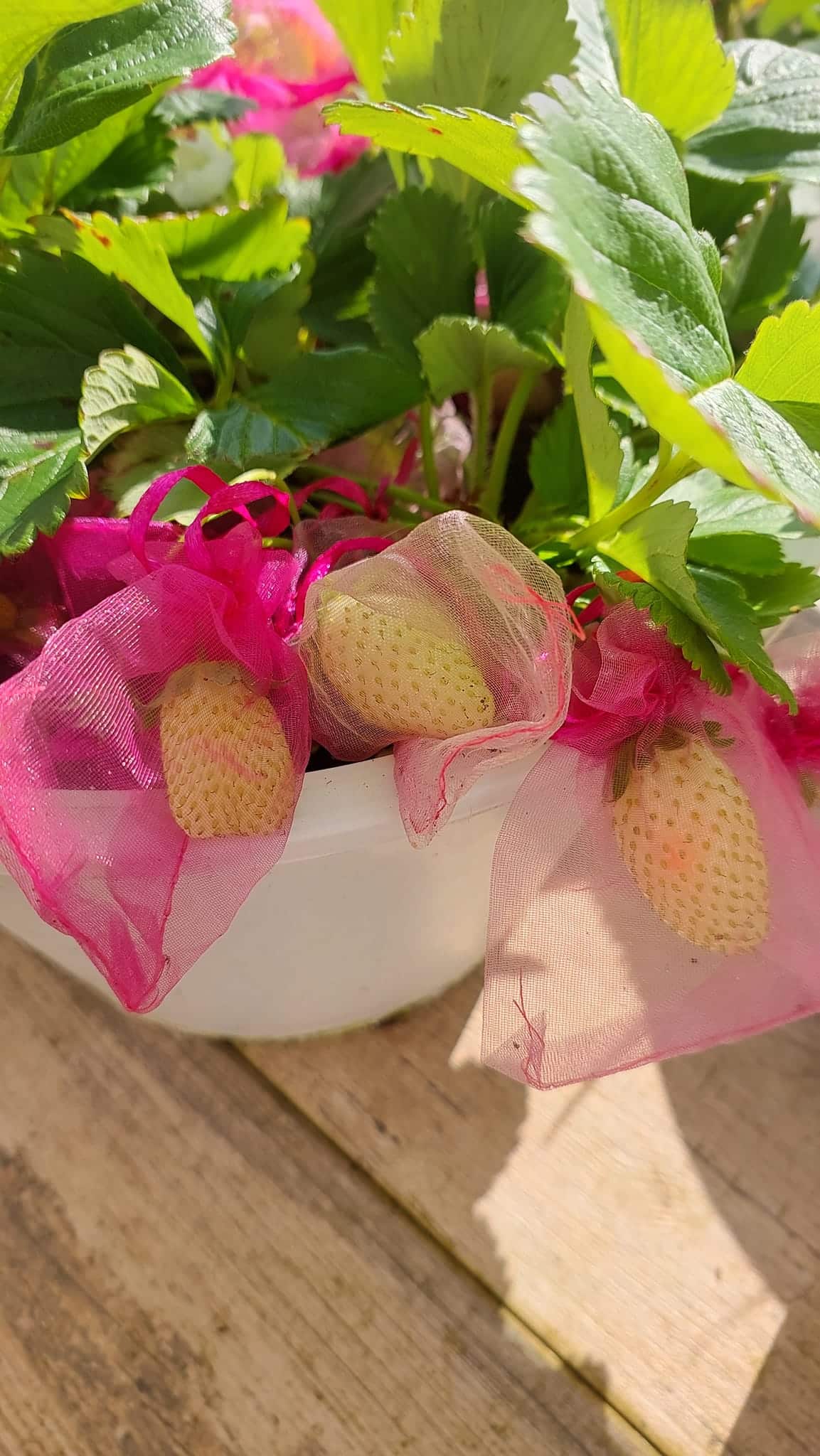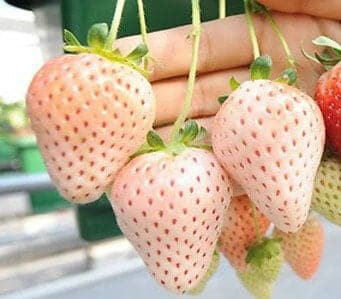There’s no denying that birds love strawberries; therefore, as you eagerly await the bountiful strawberry harvest from your garden, so do they. Birds can cause immense damage to your strawberry patch, stripping it clean of its luscious, red fruits before you get an opportunity to enjoy them.
So, how can you stop these darn birds from stealing and devouring your strawberries? There are many humane, simple strategies to protect your precious strawberries from these sneaky, pesky, feathered thieves.
In this guide, we’ll go over these strategies comprehensively so you can enjoy your strawberries without sharing them with birds.
6 Ways to Protect Your Strawberries From Birds
1. Erect Physical Barriers
Protecting your strawberry plants with physical barriers is the most reliable way to keep birds from accessing your strawberries. However, this approach requires proper timing— cover your strawberry plants after they’ve been pollinated and set fruit. If you do it too early, pollinators won’t be able to access the flowers.
Protect your strawberries once the fruits begin changing from green to red.
a) Bird Netting
This widely used method of protecting strawberries is highly effective, simple, and economical. It entails draping netting with holes too small for the birds to reach your strawberry plants.
Create a frame around your strawberry plants using PVC pipes or stakes and drape the netting over it, ensuring it covers the whole area. To make sure birds don’t reach your plants from underneath, anchor the netting’s edges with rocks, bricks, or ground staples.
Do not lay the netting directly on your strawberry plants because this setup won’t offer proper protection from birds and other small animals. In addition, the netting will get caught in the plants— you’ll have a tough time removing the net when harvest time arrives.
Also, birds can get caught in loose netting, so secure it tightly.
b) Berry Cage
If you prefer a more permanent solution, construct a strawberry cage. You can make this structure simple or intricate and even accessorize it. Your strawberry cage can remain effective for many seasons if you build it sturdily and with quality materials.
Design the cage with doors or openings if you want to avoid lifting it off during harvesting. However, a moveable berry cage is just as appealing because you can use it to protect other plants when your strawberries are safe from animals.
Construct the frame with solid, durable materials like wood, metal, and PVC pipes. As for the netting, use wire mesh or bird netting with tiny openings. Make your berry cage tall enough to accommodate plant growth and facilitate maintenance and fruit picking more easily.
Read More:
d) Cloche
Get yourself cloches if you have a few strawberry plants. Use these bell or dome-shaped enclosures to protect strawberry plants individually from birds, pests, and harsh weather conditions. Buy cloches large enough for your plants or make them yourself.
2. Scare Tactics and Deterrents
Physical barriers are exceptionally reliable but can make harvesting and pollination a bit difficult and may not be aesthetically pleasing. In that case, what’s the alternative? Try scaring or deterring them.
a) Old-School Scarecrows
Scarecrows have long been used to keep birds and other produce-eating animals out of fields and gardens, hence a proven approach. You can make or buy a scarecrow.
This classic scare tactic works, but you’ll need to move it around regularly because birds can get accustomed to it quickly. Also, consider adding shiny or sound-producing objects to the scarecrows to increase their effectiveness. Moreover, change your scarecrows’ appearance frequently.
b) Reflective Objects
Shiny objects scare birds— you can use this fear to your advantage by positioning reflective objects on your strawberry patch’s perimeter. These objects reflect light from the sun, forming glares that disorient birds and deter them from your strawberry plants.
Aside from deterring birds with flashing lights, reflective objects can also sway in the wind, creating sudden movements that can scare birds. Reflective objects you can use include:
- Old CDs or DVDs: String them together and hang them on stakes, fences, or nearby branches.
- Aluminum Foil Strips: Besides reflecting light, the wind makes them produce crinkling sounds.
- Reflective Pinwheels: They reflect light and spin in the wind, forming frightening sounds and light. They come in many patterns and colors.
- Foil Tape: They effectively deter birds but tear easily in heavy rains or strong winds, thus requiring replacing frequently.
- Aluminum Pie Tins: They are both auditory and visual bird deterrents.
c) Fake Predators
Birds have many predators, including owls, dogs, snakes, cats, and hawks. These animals instinctively fear creatures that can attack and eat them; they avoid areas where they sense danger.
You can trick birds into thinking the area around your strawberry patch isn’t safe by placing lifelike replicas of their predators where the birds often forage or land. Get high-quality fake predators that feature detailed features of real animals, including realistic eyes and accurate coloring.
Although these decoys will scare the birds away, they will eventually realize they aren’t a real threat, especially if they’re stationary. Make your fake predators believable by incorporating wind-activated or reflective elements into them. Also, move the decoys around occasionally.
d)Wind Chimes
Noise is a great bird deterrent. The sounds wind chimes produce when the wind blows them will make birds uncomfortable, discouraging them from invading your strawberry patch. If you choose a wind chime with a shiny surface, the light reflected from it will amplify its bird-repelling effect.
Besides protecting your strawberries from birds, wind chimes will add a whimsical charm to your garden. Do not use too many or overly excessively noisy wind chimes because the sounds they produce can become annoying.
e) Scare Eye Balloons
These balloons are brightly colored with a shiny, reflective surface and fierce, mock predatory eyes printed on them. The reflective surface and the scary eyes confuse and frighten birds into steering clear of your garden and strawberries.
Since scare eye balloons are lightweight, the wind easily sways them, increasing their effectiveness.
f) Let Your Dog or Cat Outside
Even if your pet doesn’t actively chase or hunt birds, their mere presence can make your garden and strawberry patch an unfriendly environment for them. So, why not let them roam in the garden?
As your pet explores your garden, their movement and noises can scare away birds. Let your pets outside if you are comfortable doing so and can supervise them.
Note
Your cats and dogs cannot always be outside, so you may need to supplement this method with other approaches.
g) Companion Planting
Interplanting certain herbs and flowering plants with your strawberry plants or placing them around the patch’s perimeter can repel birds because of their smell. Some worthy options are lavender, basil, garlic, mint, thyme, onions, and basil.
You can mix multiple companion plants and rotate them. However, don’t overcrowd your strawberry patch with these plants.
3. Decoy Strawberries
This approach is creative and fun; you can involve your kids in executing it. Pain a bunch of rocks to resemble strawberries and scatter them around your strawberry plants. When birds try to peck these fake berries, they will discover they aren’t real.
Over time, birds will lose interest in your garden, associating it with areas without food, thus discouraging their return. Start using decoy strawberries early in the growing season to train the birds to lose interest in your garden before your strawberries ripen.
4. Set Up Birdbaths
Perhaps birds are eating your strawberries because they are thirsty rather than hungry. So, while it may seem counterintuitive to make your home inviting for birds by providing an easily accessible water source, it can make them leave your strawberries alone.
Set up a small pond, tiny fountain, or birdbath far from your strawberry patch but visible from your garden. In addition, ensure the area is safe and free of predators.
Clean the water source frequently and change the water regularly to keep this space attractive to birds.
5. Provide An Alternative Food Source
Besides to hydrate, birds eat strawberries because they are hungry. Similar to providing a water source, giving birds an alternative food source can help protect your strawberries from them. Birds are less likely to forage if they have a reliable, enticing source of food.
Install bird feeders strategically around your outdoor spaces (keep them away from your strawberry patch) and fill and consistently refill them with favorite bird foods. These include sunflower seeds, millet, and safflower seeds.
Note
Turning your home into a steady food source may attract more animals to your garden and, consequently, your strawberries. Providing a water source may have a similar effect, so proceed cautiously.
6) Plant White Strawberries
Bright colors attract birds, which is why ripe red strawberries are a magnet for them. Therefore, birds might consider white strawberries inedible or unripe. Reduce their interest in your strawberry patches by growing white varieties.
Keep in mind that this approach isn’t foolproof, as birds may eventually discover that white strawberries are edible, so combine it with other measures.
Final Remarks
With some effort, birds won’t be a problem in your strawberry patch. Combining multiple methods works best to protect your strawberries from birds. Explore various approaches to discover which works best in your garden. Also, protect your strawberries without harming the birds and other wildlife.

Hey there, fellow plant enthusiasts! I’m Rachel, the green-thumbed writer behind Rooted In Garden. With a deep-rooted love for all things botanical, I’ve made it my mission to help you cultivate a thriving collection of houseplants. As a devoted plant parent myself, I understand the joys and challenges that come with nurturing these leafy wonders. Whether you’re a succulent aficionado, an orchid enthusiast, or simply adore all potted flora, join me on this journey as we explore the secrets to growing and caring for our beloved green companions. Together, let’s create a flourishing oasis indoors.







